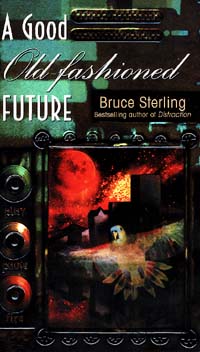https://www.austinchronicle.com/books/1999-07-23/522412/
Future Near, Future Dear
By Clay Smith, July 23, 1999, Books
|
photograph by Todd V. Wolfson |
A Good Old-fashioned Future
by Bruce Sterling
Bantam Spectra, $6.99 paper
It's obvious from reading A Good Old-fashioned Future, Bruce Sterling's new collection of seven previously published stories, that the author has struck a deal with his Muse. "You give me license to use all sort of words no one has ever heard of," he must have begged her, "and in return I'll see to it ..." that what? That the near future is described in a chillingly convincing fashion? That readers will be forced to contemplate the logical conclusion of postmodernity, that people in the near future -- approximately the mid-21st century -- will be able to "read" crucial facts about one another without really knowing one another, using little cards called "spex" they wear around their necks? Sterling's universe is dire and fraught with a Big Brother-like power structure that, much to Sterling's credit, is never arrayed in full detail but left lurking in all its menacing, penumbral desperation. To call it "Orwellian," however, would be a mistake; there's plenty of fun to be had in Bruce Sterling's universe.
The fact that Sterling uses words previously uncataloged in any human vocabulary is the telltale sign that this is science fiction, the genre Susan Sontag once termed "dubious." Readers who can't stomach science fiction often cite the disregard for the laws of nature the genre so willfully suspends as reason enough to at least ignore and preferably burn its hallmark texts. They can't stand the insular, clubby weirdness science fiction seems to inspire in its most avid readers. A Good Old-fashioned Future, not by any means one of Sterling's major books, is still, I think, reason enough for high-culture connoisseurs of literary fiction and, as we like to say, "serious nonfiction," to cross the clearly demarcated literary camp boundaries into the near future. There's much to recognize -- plenty of big words and complex construction. In "Deep Eddy," the most memorable story, abstract nouns take center stage to delightful effect: "Today, duty called Deep Eddy to Düsseldorf in Europe. Duty did not have to call very hard to get Eddy's attention." One paragraph later: "Well, danger and Deep Eddy were fast friends." In the same story, in which it is the task of Deep Eddy (Mr. Edward Dertouzas) to travel from Chattanooga to Düsseldorf to deliver data embedded in a 20th-century copy of Elias Canetti's Crowds and Power to a man called the Cultural Critic, the humanity high-minded readers are always carping about is actually in existence. At this point in the story, Eddy has arrived in Düsseldorf and is on his way to meet the Cultural Critic when he and his bodyguard Sardelle happen to walk beside the Rhine, where Eddy makes himself at home in a distinctly nonrobotic fashion:
The banks were lined with municipal gardens: grape-musky vineyards, big pale meticulous flowerbeds. Tireless gardening robots had worked them over season by season with surgical trowels. Eddy stooped by the riverbank and scooped up a double-handful of backwash from a passing hydrofoil. He saw his own spex-clad face in the moony puddle of his hands. As Sardelle watched, he sipped a bit and flung the rest out as libation to the spirit of place.
"I'm happy now," he said. "Now I'm really here."
|
|
But then, any effort to trump up the literary aspects of Sterling's stories would be foolish. The elements of "Deep Eddy" cited above, though, provide a hint of something crucial aboutA Good Old-fashioned Future: the jarring sensation it induces. Sterling employs entirely traditional narrative techniques to describe nontraditional occurrences, which increases the likelihood of it all, makes you believe that yes, in the near future, people will be able to decipher your personality by utilizing a little card hung around the neck. In "The Littlest Jackal," a mocking but hyper-masculine spy story, Sterling writes that one character's politics (which in these stories is literary shorthand for character description) are "shaded toward Pamyat rightism with a mystical pan-Slavic spin" and then simply moves on to reveal his character's next action: "[He] patted the granite base of the Obelisk with open pleasure." There are two possible reactions to this. Since that "Pamyat rightism" phrase really makes no sense whatsoever, it's maddening, as if the reader just isn't in on the joke. The joke, of course, is in the satire. Sterling isn't entirely at home in the worlds he creates in this book, as if he simultaneously revels in and is ill at ease with what occurs in his stories.
That there's a definable "sensibility" afoot here is all the more laudable given that gliding through these stories is an entirely viable approach. It's June 27, 2037, in "Bicycle Repairman," and the bicycle repairman, Lyle Schweik, lives in Chattanooga's "damage zone," where people don't go unless they want to be among hoodlums and fend for themselves in a kind of Mad Max way. Lyle lives there; one day a newcomer to the zone, Kitty Casaday, asks him to fix her bike and begins querying him about his extra room and whether she might be able to rent it from him. Lyle says he'll consider it, though he really doesn't want her there. He leaves the zone to have dinner with his mother and returns to find his shop vandalized by none other than Kitty Casaday, federal agent, who is nearly in shock from the 15,000 volts Lyle's "shock-baton" delivers to would-be intruders. He checks to make sure she's alive and goes to work ensnaring her in a spidery fashion:
Lyle thought over the design problem for some time, and then fetched a big heat-reflective blanket out of the empty room. He cut a neat poncho-hole in the center of it, and slipped her head through it. He got the bike cables off her -- she could probably slip the cables anyway -- and sewed all four edges of the blanket shut from the outside, with sturdy monofilament thread from the saddle-stitcher. He sewed the poncho edges to a tough fabric belt, cinched the belt snugly around her neck, and padlocked it. When he was done, he'd made a snug bag that contained her entire body, except for her head, which had begun to drool and snore.
Sterling's fascination with the mechanics of how people live in the near future and the gadgetry they use is half the fun of reading A Good Old-fashioned Future (the remaining fun is occupied by decoding the author's vocabulary). It's such a wild ride that it almost forces you to forget why you're there: "So let's enjoy our time here," Eddy's bodyguard Sardelle says to him at one point. "Idleness is sweet. Even on the edge of dirty chaos."
Bruce Sterling will read from and sign A Good Old-fashioned Future at Adventures in Crime and Space on Saturday, July 24, from 3-5pm.
Copyright © 2024 Austin Chronicle Corporation. All rights reserved.


